Desertification and Related Climate Change in the Alashan Plateau since the Last 40 ka of the Last Glacial Period
Abstract
1. Natural Background
2. Paleo-Climate Records and Paleo-Environmental Reconstruction since the Last 40 ka Period
3. Potential Causes of Paleo-Climate Changes and the Controversy Views about the Alashan Plateau
3.1. Causes of Climate Change during the Last Glacial Period on the Alashan Plateau
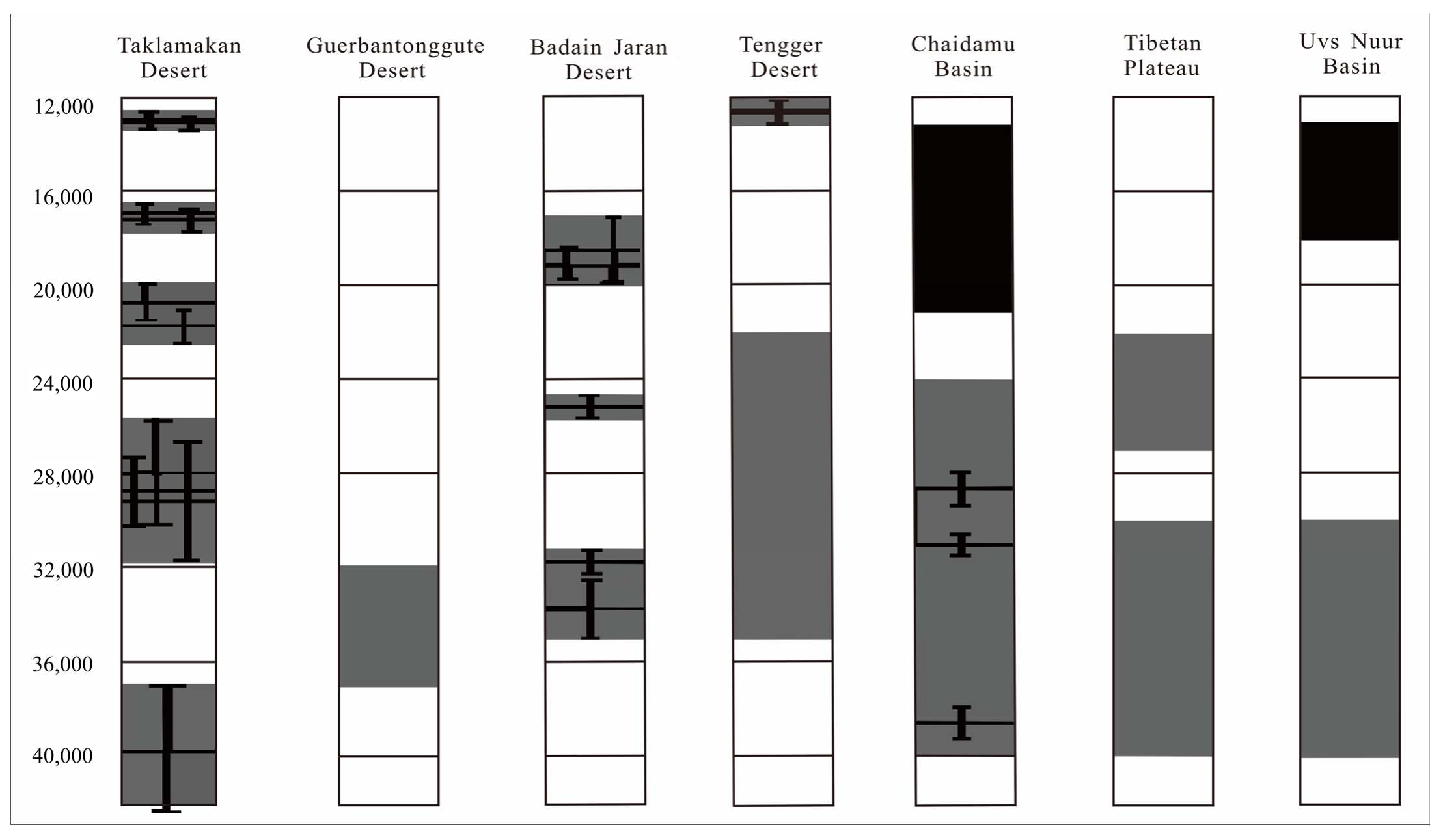
3.2. Causes of Holocene Climate Change on the Plateau
3.3. The Accuracy of Climatic Proxy Indicators and the Complexity and Uncertainty of Regional Environmental Elements
3.4. Different Understandings of the Roles of the Monsoon and Westerly Circulation Systems in the Mid-Latitudes
3.5. Complexity of Dynamic Connection between Westerly and Monsoon Circulation Effects and Ocean Circulation in Mid-Latitude Regions
3.6. Role of Holocene Insolation and ITCZ on a Global Scale
4. Aeolian Landforms Evolution and Climate Change of the Alashan Plateau
4.1. Provenance of Desert Sands
4.2. Forces Driving the Transportation of Aeolian Sand on the Alashan Plateau
4.3. Formation of Tall Sand Mountains
4.4. Desertification and Environmental Change
5. Conclusions
- (1)
- The climate change of the Alashan Plateau since the last glacial period has a good correspondence with global climate change on the orbital, suborbital, and millennium scales, but there is a relative lack of records and evidence of typical climate events.
- (2)
- From about 40 ka of the last glacial period to the end of the last glacial maximum, the climate was wetter than at present, which was not conducive to further desertification on the plateau. The climate was then generally arid, and desertification strengthened until the end of the Pleistocene. However, the climate in the Wulanbuhe Desert was still wet during this period, and the reason remains unclear.
- (3)
- The temperature during the Holocene was higher on the plateau. The climate was generally humid in the early and middle Holocene; the lakes were further developed, and the desertification was weak in these stages. In the late Holocene, the climate was arid, and desertification was strong. Among them, the climate change of the Tenggeli Desert in the early Holocene is opposite the overall trend of climate change on the plateau. As for the drought event in the middle Holocene, it is still controversial whether the spatial scale is local or regional on the plateau, which needs to be further discovered.
- (4)
- In terms of the causes of climate change, it is generally believed that the climate changes of the study area are affected by the two major circulation systems of the westerlies and the East Asian monsoon, and the two have different effects in different periods. Although great achievements have been made on the evolution of the East Asian monsoon in geology, the specific mechanism and degree of the influences of the two need to be confirmed and improved by more climatological and meteorological evidence. In addition, the impacts of the Qinghai–Tibet Plateau and the Yellow River cannot be ignored, and the influence of human activities should also be considered on different time scales. Although this effect is relatively small on the millennium scale, the recent effect on the local or regional scale cannot be negligible.
- (5)
- In terms of desertification, the landscape of the Alashan Plateau is distinctive because of the existence of tall, sandy mountains, but there is no unified conclusion on the source of desert sand. In particular, the geomorphic coexistence phenomenon of tall sand dunes and permanent lakes is difficult to explain by the traditional theory of climatic geomorphology. The explanation of its formation mechanism and evolution process requires more geoscientific evidence, such as geophysics and geochronology. The wind direction and wind energy indicated by the shifting-trend and distribution characteristics of sand dunes and the attributes of sand-transporting wind and its contribution to the provenance of desert dunes reflected in the wind field data further confirm that desertification generally corresponds to periods of cold and arid climate. As one of the desert landscapes, the establishment of sand dunes requires appropriate wind energy, and the defined range of this “appropriate” energy needs further study.
- (6)
- In our future work, since the climate change of the Alashan Plateau is dominated by the patterns of the cold dry and cold wet (or warm humid) modes, it will be more helpful for us to compare and analyze the trend of regional-scale climate change against the background of a warming climate and to further clarify the relationship of climate change between the Alashan Plateau and the global. A key to answering this question may be the need to integrate the earth system sciences such as the westerlies, the EASM, the effect of the Atlantic–Pacific Ocean Circulation Anomaly, the third polar environmental effect of the Qinghai–Tibet Plateau, the hydrological effect of the Yellow River, etc. It also needs to integrate more cooperative research between climatologists, hydrologists, oceanographers, geologists, geomorphologists, geophysicists, and paleoclimatologists. In addition, due to the complexity of the desertification with aeolian sediments from source to sink, the research on the provenance of desert sand on the Alashan Plateau needs to combine more environmental elements and try to conduct comprehensive sampling and experimental analysis in as large a range as possible between the potential source areas of clastic materials (such as plateaus and mountains), transition zones (such as Piedmont and planation terrains, alluvial/proluvial fans, gobi deserts, river deltas, terminal lakes, etc.), and depositional zones (such as dune fields).
Author Contributions
Funding
Institutional Review Board Statement
Informed Consent Statement
Data Availability Statement
Acknowledgments
Conflicts of Interest
References
- Yang, X. Desert research in northwestern China-a brief review. Geomorphol. Relief Process. Env. 2006, 12, 275–283. [Google Scholar] [CrossRef]
- Yang, X.; Forman, S.; Hu, F.; Zhang, D.; Liu, Z.; Li, H. Initial insights into the age and origin of the Kubuqi sand sea of northern China. Geomorphology 2016, 259, 30–39. [Google Scholar] [CrossRef]
- Yang, X.; Rost, K.T.; Lehmkuhl, F.; Zhu, Z.; Dodson, J. The evolution of dry lands in northern China and in the Republic of Mongolia since the Last Glacial Maximum. Quat. Int. 2004, 118–119, 69–85. [Google Scholar] [CrossRef]
- Yang, X.; Li, H.; Conacher, A. Large-scale controls on the development of sand seas in northern China. Quat. Int. 2012, 250, 74–83. [Google Scholar] [CrossRef]
- Guo, Z. Loess Plateau attests to the onsets of monsoon and deserts. Sci. Sin. Terrae 2017, 47, 421–437, (In Chinese with English Abstract). [Google Scholar]
- Guo, Z.; Sun, B.; Zhang, Z.; Peng, S.; Xiao, G.; Ge, J.; Hao, Q.; Qiao, Y.; Liang, M.; Liu, J.; et al. A major reorganization of Asian climate regime by the early Miocene. Clim. Past Discuss. 2008, 4, 535–584. [Google Scholar]
- Zhang, Z.; Wang, H.; Guo, Z.; Jiang, D. What triggers the transition of palaeoenvironmental patterns in China, the Tibetan Plateau uplift or the Paratethys Sea retreat? Palaeogeogr. Palaeoclimatol. Palaeoecol. 2007, 245, 317–331. [Google Scholar]
- Zhang, Z.; Wang, H.; Guo, Z.; Jiang, D. Impacts of tectonic changes on the reorganization of the Cenozoic paleoclimatic patterns in China. Earth Planet. Sci. Lett. 2007, 257, 622–634. [Google Scholar]
- Chen, F.; Wu, W.; Holmes, J.A.; Madsen, D.B.; Zhu, Y.; Jin, M.; Oviatt, C.G. A mid-Holocene drought interval as evidenced by lake desiccation in the Alashan Plateau, Inner Mongolia, China. Chin. Sci. Bull. 2003, 48, 1401–1410. [Google Scholar] [CrossRef]
- Yang, X.; Liu, T.S.; Xiao, H. Evolution of megadunes and lakes in the Badain Jaran Desert, Inner Mongolia, China during the last 31,000 years. Quat. Int. 2003, 104, 99–112. [Google Scholar] [CrossRef]
- Dong, Z.; Wang, T.; Wang, X. Geomorphology of the megadunes in the Badain Jaran Desert. Geomorphology 2004, 60, 191–203. [Google Scholar] [CrossRef]
- Chen, F.; Fan, Y.; Chun, X.; Madsen, D.B.; Oviatt, C.G.; Zhao, H.; Yang, L.; Sun, Y. Preliminary research on Megalake Jilantai-Fletao in the arid areas of China during the Late Quaternary. Chin. Sci. Bull. 2008, 53, 1729–1735. [Google Scholar]
- Chen, F.; Yu, Z.; Yang, M.; Ito, E.; Wang, S.; Madsen, D.B.; Huang, X.; Zhao, Y.; Sato, T.; Birks, H.J.B.; et al. Holocene moisture evolution in arid central Asia and its out-of-phase relationship with Asian monsoon history. Quat. Sci. Rev. 2008, 27, 351–364. [Google Scholar] [CrossRef]
- Chen, H.; Song, S.R.; Lee, T.Q.; Lowemark, L.; Chi, Z.; Wang, Y.; Hong, E. A multiproxy lake record from Inner Mongolia displays a late Holocene teleconnection between Central Asian and North Atlantic climates. Quat. Int. 2010, 227, 170–182. [Google Scholar] [CrossRef]
- Fan, Y.; Chen, F.; Fan, T.; Zhao, H.; Yang, L. Sedimentary documents and Optically Stimulated Luminescence (OSL) dating for formation of the present landform of the northern Ulan Buh Desert, northern China. Sci. China Earth Sci. 2010, 53, 1675–1682. [Google Scholar] [CrossRef]
- Yang, X.; Ma, N.; Dong, J.; Zhu, B.; Xu, B.; Ma, Z.; Liu, J. Recharge to the inter-dune lakes and Holocene climatic changes in the Badain Jaran Desert, western China. Quat. Res. 2010, 73, 10–19. [Google Scholar] [CrossRef]
- Yang, X.; Scuderi, L.; Liu, T.; Paillou, P.; Li, H.; Dong, J.; Zhu, B.; Jiang, W.; Jochems, A.; Weissmann, G. Formation of the highest sand dunes on Earth. Geomorphology 2011, 135, 108–116. [Google Scholar] [CrossRef]
- Yang, X.; Scuderi, L.; Paillou, P.; Liu, Z.; Li, H.; Ren, X. Quaternary environmental changes in the dry lands of China—A critical review. Quat. Sci. Rev. 2011, 30, 3219–3233. [Google Scholar] [CrossRef]
- Dong, Z.; Qian, G.; Lv, P.; Hu, G. Investigation of the sand sea with the tallest dunes on Earth: China’s Badain Jaran Sand Sea. Earth Sci. Rev. 2013, 120, 20–39. [Google Scholar] [CrossRef]
- Li, G.; Jin, M.; Wen, L.; Zhao, H.; Madsen, D.; Liu, X.; Wu, D.; Chen, F. Quartz and K-feldspar optical dating chronology of eolian sand and lacustrine sequence from the southern Ulan Buh Desert, NW China: Implications for reconstructing late Pleistocene environmental evolution. Palaeogeogr. Palaeoclimatol. Palaeoecol. 2014, 393, 111–121. [Google Scholar] [CrossRef]
- Ren, X.; Yang, X.; Wang, Z.; Zhu, B.; Zhang, D.; Rioual, P. Geochemical evidence of the sources of Aeolian sands and their transport pathways in the Minqin Basin, northwestern China. Quat. Int. 2014, 334–335, 165–178. [Google Scholar] [CrossRef]
- Li, G.; Jin, M.; Chen, X.; Wen, L.; Zhang, J.; Madsen, D.; Zhao, H.; Wang, X.; Fan, T.; Duan, Y.; et al. Environmental changes in the Ulan Buh Desert, southern Inner Mongolia, China since the middle Pleistocene based on sedimentology, chronology and proxy indexes. Quat. Sci. Rev. 2015, 128, 69–80. [Google Scholar] [CrossRef]
- Wang, F.; Sun, D.; Chen, F.; Bloemendal, J.; Guo, F.; Li, Z.; Zhang, Y.; Li, B.; Wang, X. Formation and evolution of the Badain Jaran Desert, North China, as revealed by a drill core from the desert center and by geological survey. Palaeogeogr. Palaeoclimatol. Palaeoecol. 2015, 426, 139–158. [Google Scholar] [CrossRef]
- Hu, F.; Yang, X. Geochemical and geomorphological evidence for the provenance of aeolian deposits in the Badain Jaran Desert, northwestern China. Quat. Sci. Rev. 2016, 131, 179–192. [Google Scholar] [CrossRef]
- Zhu, B.; Zhang, J.; Sun, C. Physiochemical characteristics, provenance, and dynamics of sand dunes in the arid Hexi Corridor. Front. Earth Sci. 2021, 9, 728202. [Google Scholar] [CrossRef]
- Wang, X.; Geng, X.; Liu, B.; Cai, D.; Li, D.; Xiao, F.; Zhu, B.; Hua, T.; Lu, R.; Liu, F. Desert ecosystems in China: Past, present, and future. Earth Sci. Rev. 2022, 234, 104206. [Google Scholar] [CrossRef]
- Zhu, B. The recent evolution of dune landforms and its environmental indications in the mid-latitude desert area (Hexi Corridor). J. Geogr. Sci. 2022, 32, 617–644. [Google Scholar] [CrossRef]
- Zhu, B. Mechanism of land degradation and their environmental implications in a middle-latitude desert area of China. Land Degrad. Dev. 2022, 33, 145–178. [Google Scholar] [CrossRef]
- Zhu, B.; Zhang, J.; Sun, C. Potential links of gobi, dust, and desertification: A comprehensive understanding from aeolian landforms evolution in a middle-latitude desert. Sediment. Geol. 2022, 428, 106049. [Google Scholar] [CrossRef]
- Chen, J.; Chen, Q.; Wang, T. Isotopes tracer research of wet sand layer water sources in Alxa Desert. Adv. Water Sci. 2014, 25, 196–206, (In Chinese with English Abstract). [Google Scholar]
- Zheng, R.; Li, J.; Xiao, W.; Liu, J.; Wu, T. Discovery of Silurian Pluton in the Enger Us region in the northern margin of Alxa Block. Acta Geol. Sin. 2016, 90, 1725–1736. [Google Scholar]
- Herzschuh, U.; Tarasov, P.; Wünnemann, B.; Hartmann, K. Holocene vegetation and climate of the Alashan Plateau, NW China, reconstructed from pollen data. Palaeogeogr. Palaeoclimatol. Palaeoecol. 2004, 211, 1–17. [Google Scholar] [CrossRef]
- Wang, X.; Xia, D.; Wang, T.; Xue, X.; Li, J. Dust sources in arid and semiarid China and southern Mongolia: Impacts of geomorphologic setting and surface materials. Geomorphology 2008, 97, 583–600. [Google Scholar] [CrossRef]
- Zhang, H.; Peng, J.; Ma, Y.; Chen, G.; Feng, Z.; Li, B.; Fan, H.; Chang, F.; Lei, G.; Wünnemann, B. Late Quaternary palaeolake levels in Tengger Desert, NW China. Palaeogeogr. Palaeoclimatol. Palaeoecol. 2004, 211, 45–58. [Google Scholar] [CrossRef]
- Zhao, Y.; Yu, Z.; Chen, F.; Li, J. Holocene vegetation and climate change from a lake sediment record in the Tengger Sandy Desert, northwest China. J. Arid. Environ. 2008, 72, 2054–2064. [Google Scholar] [CrossRef]
- Zhao, H.; Li, G.; Sheng, Y.; Jin, M.; Chen, F. Early-middle Holocene lake desert evolution in northern Ulan Buh Desert, China. Palaeogeogr. Palaeoclimatol. Palaeoecol. 2012, 331–332, 31–38. [Google Scholar] [CrossRef]
- Yang, X. Changes of the aridity index in the arid regions of northwestern China since the Late Pleistocene-An understanding based on climate geomorphology. Z. Geomorphol. 2002, 126, 169–181. [Google Scholar]
- Wünnemann, B.; Hartmann, K. Morphodynamics and paleohydrography of the Gaxun Nur Basin, Inner Mongolia, China. Z. Geomorphol. 2002, 126, 147–168. [Google Scholar]
- Yang, X. Landscape evolution and precipitation changes in the Badain Jaran Desert during the last 30,000 years. Chin. Sci. Bull. 2000, 45, 1042–1047. [Google Scholar] [CrossRef]
- Pachur, H.J.; Wünnemann, B. Lake Evolution in the Tengger Desert, Northwestern China, during the Last 40,000 Years. Quat. Res. 1995, 44, 171–180. [Google Scholar] [CrossRef]
- Yang, X. Late Quaternary wetter epochs in the southeastern Badain Jaran Desert, Inner Mongolia, China. Z. Geomorphol. 2004, 133, 129–141. [Google Scholar]
- Li, Z. Palaeolake Chronology and Climate Background on Badain Jaran Desert and Its Marginal Area during the Late Quaternary. Ph.D Thesis, Lanzhou University, Lanzhou, China, 2012. (In Chinese with English Abstract). [Google Scholar]
- Zhang, H.; Wünnemann, B.; Ma, Y.; Peng, J.; Pachur, H.J.; Li, J.; Qi, Y.; Chen, G.; Fang, H.; Feng, Z. Lake Level and Climate Changes between 42,000 and 18,000 14C yr B.P. in the Tengger Desert, Northwestern China. Quat. Res. 2002, 58, 62–72. [Google Scholar] [CrossRef]
- Chen, X.; Li, G.; Huang, X.; Zhao, H. The vegetation changes in Ulan Buh desert since the last glacial: Pollen evidence from core WL10ZK-1. Mar. Geol. Quat. Geol. 2013, 33, 169–174, (In Chinese with English Abstract). [Google Scholar] [CrossRef]
- Chun, X.; Chen, F.; Fan, Y. Formation of Ulan Buh desert and its environmental changes during the Holocene. Front. Earth Sci. China 2008, 2, 327–332. [Google Scholar] [CrossRef]
- Hartmann, K.; Wünnemann, B. Hydrological changes and Holocene climate variations in NW China, inferred from lake sediments of Juyanze palaeolake by factor analyses. Quat. Int. 2009, 194, 28–44. [Google Scholar] [CrossRef]
- Chen, C.; Lan, H.; Lou, J.; Chen, Y. The dry Holocene megathermal in Inner Mongolia. Palaeogeogr. Palaeoclimatol. Palaeoecol. 2003, 193, 181–200. [Google Scholar] [CrossRef]
- Chen, F.; Cheng, B.; Zhao, Y.; Zhu, Y.; Madsen, D. Holocene environmental change inferred from high resolution pollen records of inland lake deposits, arid China. Holocene 2006, 16, 675–684. [Google Scholar] [CrossRef]
- Wunnemann, B.; Hartmann, K.; Janssen, M.; Zhang, H. Responses of Chinese desert lakes to climate instability during the past 45,000 years. In Late Quaternary Climate Change and Human Adaptation in Arid China. Developments in Quaternary Science; Madsen, D.B., Chen, F., Gao, X., Eds.; Elsevier: Amsterdam, The Netherlands, 2007; Volume 9, pp. 11–24. [Google Scholar]
- Xiao, J.; Xu, Q.; Nakamura, T.; Yang, X.; Liang, W.; Inouchi, Y. Holocene vegetation variation in the Dahai lake region of north-central China: A direct indication of the Asian monsoon climate history. Quat. Sci. Rev. 2004, 23, 1669–1679. [Google Scholar]
- Long, H.; Lai, Z.; Fuchs, M.; Zhang, J.; Li, Y. Timing of Late Quaternary palaeolake evolution in Tengger Desert of northern China and its possible forcing mechanisms. Glob. Planet. Chang. 2012, 92–93, 119–129. [Google Scholar] [CrossRef]
- Chun, X.; Chen, F.; Fan, Y.; Xia, D.; Zhao, H. Formation of Ulan Buh Desert and its environmental evolution. J. Desert Res. (In Chinese with English Abstract). 2007, 27, 927–931. [Google Scholar]
- Yang, X. Late Quaternary variation of the aridity index in the Badain Jaran Desert, Inner Mongolia, China-a deduction from landscape evolutions. Sci. Geol. Sin. 2000, 9, 205–214. [Google Scholar]
- Yang, X. Late Quaternary evolution and paleoclimates, western Alashan Plateau, Inner Mongolia, China. Z. Geomorphol. 2001, 1, 1–16. [Google Scholar]
- Zhao, Y.; Yu, Z.; Chen, F.; Liu, X.; Ito, E. Sensitive response of desert vegetation to moisture change based on a near annual resolution pollen record from Gahai Lake in the Qaidam Basin, northwest China. Glob. Planet. Chang. 2008, 62, 107–114. [Google Scholar] [CrossRef]
- Yu, G.; Xue, B.; Wang, S.; Liu, J. Lake records and LGM climate in China. Chin. Sci. Bull. 2000, 45, 1158–1164. [Google Scholar] [CrossRef]
- Zheng, M.; Meng, Y.; Wei, L. Evidence of the pan-lake stage in the period of 40–28 ka B.P. on the Qinghai-Tibet Plateau. Acta Geol. Sin. 2000, 74, 266–272. [Google Scholar]
- Yang, X.; Preusser, F.; Radtke, U. Late Quaternary environmental changes in the Taklamakan Desert, western China, inferred from OSL-dated lacustrine and aeolian deposits. Quat. Sci. Rev. 2006, 25, 923–932. [Google Scholar] [CrossRef]
- Jin, L.; Chen, F.; Ganopolski, A.; Claussen, M. Response of East Asian climate to Dansgaard/Oeschger and Heinrich events in a coupled model of intermediate complexity. J. Geophys. Res. 2007, 112, D06117. [Google Scholar] [CrossRef]
- An, Z.; Colman, S.M.; Zhou, W.; Li, X.; Brown, E.T.; Timothy Jull, A.J.; Cai, Y.; Huang, Y.; Lu, X.; Chang, H.; et al. Interplay between the Westerlies and Asian monsoon recorded in Lake Qinghai sediments since 32 ka. Sci. Rep. 2012, 2, 619. [Google Scholar] [CrossRef]
- Yang, X.; Scuderi, L.A. Hydrological and climatic changes in deserts of China since the late Pleistocene. Quat. Res. 2010, 73, 1–9. [Google Scholar] [CrossRef]
- Qin, X.; Yin, Z.; Wang, M.; Zhao, W.; Mu, Y.; Zhang, L. Loess records of the Holocene climate change of Gonghe and Guide basins in the northeastern Boundary of the Tibet Plateau. Acta Geol. Sin. 2017, 91, 266–286, (In Chinese with English Abstract). [Google Scholar]
- Su, Z.; Zhang, M. Evolutionary response to Quaternary climate aridification and oscillations in north-western China revealed by chloroplast phylogeography of the desert shrub Nitraria sphaerocarpa (Nitrariaceae). Biol. J. Linn. Soc. 2013, 109, 757–770. [Google Scholar] [CrossRef]
- Wang, W.; Feng, Z. Holocene moisture evolution across the Mongolian Plateau and its surrounding areas: A synthesis of climatic records. Earth Sci. Rev. 2013, 122, 38–57. [Google Scholar] [CrossRef]
- Yin, Y.; Liu, H.; Liu, G.; Hao, Q.; Wang, H. Vegetation responses to mid-Holocene extreme drought events and subsequent long-term drought on the southeastern Inner Mongolian Plateau, China. Agric. For. Meteorol. 2013, 178–179, 3–9. [Google Scholar] [CrossRef]
- Wang, W.; Ma, Y.; Feng, Z.; Narantsetseg, T.; Liu, K.B.; Zhai, X. A prolonged dry mid-Holocene climate revealed by pollen and diatom records from Lake Ugii Nuur in central Mongolia. Quat. Int. 2011, 229, 74–83. [Google Scholar] [CrossRef]
- An, C.; Chen, F.; Barton, L. Holocene environmental changes in Mongolia: A review. Glob. Planet. Chang. 2008, 63, 283–289. [Google Scholar] [CrossRef]
- Herzschuh, U. Palaeo-moisture evolution in monsoonal Central Asia during the last 50,000 years. Quat. Sci. Rev. 2006, 25, 163–178. [Google Scholar] [CrossRef]
- Davis, B.A.S.; Brewer, S.; Stervenson, A.C.; Guiot, J.; Contributors, D. The temperature of Europe during the Holocene reconstructed from pollen data. Quat. Sci. Rev. 2003, 22, 1701–1706. [Google Scholar] [CrossRef]
- Berger, A.; Loutre, M.F. Insolation values for the climate of the last 10 million years. Quat. Sci. Rev. 1991, 10, 297–317. [Google Scholar] [CrossRef]
- Wang, N.; Li, Z.; Cheng, H.; Li Yu, Huang, Y. High lake levels on Alxa Plateau during the late Quaternary. Chin. Sci. Bull. 2011, 56, 1799–1808. [Google Scholar] [CrossRef]
- Liu, S.; Chu, G.; Lai, Z. Determination of age and sedimentation rates using radionuclide (210Pb and 137Cs) dating in inter-dune lakes of the Badain Jaran Desert, China. Acta Geol. Sin. 2016, 90, 2013–2022. [Google Scholar]
- Shi, Q.; Chen, F.; Zhu, Y.; Madsen, D. Lake evolution of the terminal area of Shiyang River drainage in arid China since the last glaciation. Quat. Int. 2002, 93–94, 31–43. [Google Scholar] [CrossRef]
- Li, Z.; Wang, N.; Cheng, H.; Ning, K.; Zhao, L.; Li, R. Formation and environmental significance of late Quaternary calcareous root tubes in the deserts of the Alashan Plateau, northwest China. Quat. Int. 2015, 372, 167–174. [Google Scholar] [CrossRef]
- Zhang, P.; Su, H.; Gong, G. The influence of climate change on the distribution boundaries of wild animals. In The Climate and Environment of the Holocene Megathermal Period in China; Shi, Y., Kong, Z., Eds.; Ocean Publication: Beijing, China, 1992; pp. 192–196. (In Chinese) [Google Scholar]
- Lehmkuhl, F.; Lang, A. Geomorphological investigations and luminescence dating in the southern part of the Khangay and the valley of the Gobi lakes (Central Mongolia). J. Quat. Sci. 2001, 16, 69–87. [Google Scholar] [CrossRef]
- Rudaya, N.A.; Tarasov, P.E.; Dorofeyuk, N.I.; Kalugin, I.A.; Andreev, A.A.; Diekmann, B.; Daryin, A.V. Environmental changes in the Mongolian Altai during the Holocene. Archaeol. Ethnol. Anthropol. Eurasia 2008, 36, 2–14. [Google Scholar] [CrossRef]
- Zhao, Y.; Yu, Z. Vegetation response to Holocene climate change in East Asian monsoon margin region. Earth Sci. Rev. 2012, 113, 1–10. [Google Scholar] [CrossRef]
- Wang, S.; Xue, B. The regional differences of environmental changes and their relationship with the Asian monsoon since the middle Pleistocene revealed by lacustrine records in China. Acta Geol. Sin. 1998, 72, 288. [Google Scholar]
- Li, S.; Qiang, M.; Li, B.; Gao, S. Rapid climate changes at northwestern margin of East Asian Monsoon region during the last deglaciation. Geol. Rev. 2004, 50, 106–112, (In Chinese with English Abstract). [Google Scholar]
- Wang, Y.; Cheng, H.; Edwards, R.L.; Kong, X.; Shao, X.; Chen, S.; Wu, J.; Jiang, X.; Wang, X.; An, Z. Millennial-and orbital-scale changes in the East Asian monsoon over the past 224,000 years. Nature 2008, 451, 1090–1093. [Google Scholar] [CrossRef]
- Wang, P. Global monsoon in a geological perspective. Chin. Sci. Bull. 2009, 54, 1113–1136. [Google Scholar] [CrossRef]
- Li, Y.; Wang, N.; Li, Z.; Zhang, H. Holocene palynological records and their responses to the controversies of climate system in the Shiyang River drainage basin. Chin. Sci. Bull. 2011, 56, 535–546. [Google Scholar] [CrossRef]
- Li, Y.; Liu, Y. The response of lake records to the circulation system and climate zones in China since the Last Glacial Maximum. Acta Geogr. Sin. 2016, 71, 197–204, (In Chinese with English Abstract). [Google Scholar]
- Chen, Q.; Liu, Z.; Kissel, C. Clay mineralogical and geochemical proxies of the East Asian summer monsoon evolution in the South China Sea during Late Quaternary. Sci. Rep. 2017, 7, 42083. [Google Scholar] [CrossRef] [PubMed]
- Li, J. The patterns of environmental changes since late Pleistocene in northwestern China. Quat. Sci. 1990, 3, 197–204, (In Chinese with English Abstract). [Google Scholar]
- Wang, K.; Jiang, H.; Zhao, H. Atmospheric water vapor transport from westerly and monsoon over the Northwest China. Adv. Water Sci. 2005, 16, 432–438, (In Chinese with English Abstract). [Google Scholar]
- Zhou, S. Meteorology and Climatology; Higher Education Press Pub: Beijing, China, 2012; pp. 101–170. [Google Scholar]
- Seager, R.; Graham, N.; Herweijer, C.; Gordon, A.L.; Kushnir, Y.; Cook, E. Blueprints for Medieval hydroclimate. Quat. Sci. Rev. 2007, 26, 2322–2336. [Google Scholar] [CrossRef]
- Visbeck, M. The Ocean’s Role in Atlantic Climate Variability. Science 2002, 297, 2223–2224. [Google Scholar] [CrossRef]
- Zhu, X.; Sun, J. Positive feedback of winter ocean-atmosphere interaction in Northwest Pacific. Chin. Sci. Bull. 2006, 51, 2268–2274. [Google Scholar] [CrossRef]
- Hurrell, J.W. Decadal Trends in the North Atlantic Oscillation: Regional Temperatures and Precipitation. Science 1995, 269, 676–679. [Google Scholar] [CrossRef]
- Cheng, J.; Yu, F.; Pu, S.; Guo, P. Features of interdecadal variation of North Pacific Heat Storage and their relationship to the Aleutian Low. Adv. Mar. Sci. 2004, 22, 417–428, (In Chinese with English Abstract). [Google Scholar]
- Lü, J.; Ju, J.; Zhang, Q.; Tao, S. The Characteristics of ENSO cycle in different phases of Pacific Decadal Oscillation. Clim. Environ. Res. 2005, 10, 238–249, (In Chinese with English Abstract). [Google Scholar]
- Dong, X.; Xue, F.; Zeng, Q. Observational analysis and numerical simulation of the Decadal Variation in the relationship between the Aleutian Low and the Iceland Low during Boreal Winter. Clim. Environ. Res. 2014, 19, 523–535, (In Chinese with English Abstract). [Google Scholar]
- Yang, C.; Dou, T.; Li, Q.; Hao, W.; Tang, M. Study on the relationships between the Arctic Oscillation and the Pacific Decadal Oscillation and Atlantic Multidecadal Oscillation. J. Trop. Meteorol. 2014, 30, 1181–1187. [Google Scholar]
- Sun, Y.; Clemens, S.C.; Morrill, C.; Lin, X.; Wang, X.; An, Z. Influence of Atlantic meridional overturning circulation on the East Asian winter monsoon. Nat. Geosci. 2012, 5, 46–49. [Google Scholar] [CrossRef]
- Sun, B.; Li, C. Relationship between East Asian trough disturbance and tropical convective activity in winter. Chin. Sci. Bull. 1997, 42, 500–503, (In Chinese without English Abstract). [Google Scholar]
- Huang, X.; Guan, Z.; Dai, Z.; Mei, H. A further look at the interannual variations of East Asian through intensity and their impacts on winter climate of China. Acta Meteorol. Sin. 2013, 71, 416–428, (In Chinese with English Abstract). [Google Scholar]
- Yang, L.; Zhang, Q. Relationships between perturbation kinetic energy anomaly along East Asian Westerly Jet and Subtropical High in summer. J. Appl. Meteorol. Sci. 2007, 18, 452–459, (In Chinese with English Abstract). [Google Scholar]
- Yang, L.; Zhang, Q. Anomalous perturbation kinetic energy of Rossby Wave along East Asian Westerly Jet and its association with summer rainfall in China. Chin. J. Atmos. Sci. 2007, 31, 586–595, (In Chinese with English Abstract). [Google Scholar]
- Kuang, X.; Zhang, Y.; Liu, J. Relationship between Subtropical Upper-Tropospheric Westerly Jet and East Asian Winter Monsoon. Plateau Meteorol. 2008, 27, 701–712, (In Chinese with English Abstract). [Google Scholar]
- Jhun, J.G.; Lee, E.J. A New East Asian Winter Monsoon Index and Associated Characteristics of the Winter Monsoon. J. Clim. 2004, 17, 711–726. [Google Scholar] [CrossRef]
- Chang, H.; An, Z.; Wu, F.; Song, Y.; Qiang, X.; Li, L. Late Miocene-early Pleistocene climate change in the mid-latitude westerlies and their influence on Asian monsoon as constrained by the K/Al ratio record from drill core Ls2 in the Tarim Basin. Catena 2017, 153, 75–82. [Google Scholar] [CrossRef]
- Hurrell, J.W.; Dickson, R.R. Climate variability over the North Atlantic. In Marine Ecosystems and Climate Variation the North Atlantic; Stenseth, N.C., Ottersen, G., Hurrell, J.W., Belgrano, A., Eds.; Oxford University Press: Oxford, UK, 2004. [Google Scholar]
- Li, W.; Wang, K.; Fu, S.; Jiang, H. The interrelationship between regional Westerly Index and the water vapor budget in Northwest China. J. Glaciol. Geocryol. 2008, 30, 28–34, (In Chinese with English Abstract). [Google Scholar]
- Berger, A. Long-term variations of caloric insolation resulting from the earth’s orbital elements. Quat. Res. 1978, 9, 139–167. [Google Scholar] [CrossRef]
- Jury, M.R.; Huang, B. The Rossby wave as a key mechanism of Indian Ocean climate variability. Deep. Sea Res. Part I Oceanogr. Res. Pap. 2004, 51, 2123–2136. [Google Scholar] [CrossRef]
- Pinault, J.L.; Pereira, L. What speleothems tell us about long-term rainfall oscillation throughout the Holocene on a planetary scale. J. Mar. Sci. Eng. 2021, 2021, 9853. [Google Scholar] [CrossRef]
- Yancheva, G.; Nowaczyk, N.R.; Mingram, J.; Dulski, P.; Schettler, G.; Negendank, J.F.W.; Liu, J.; Sigman, D.M.; Peterson, L.C.; Haug, G.H. Influence of the intertropical convergence zone on the East Asian monsoon. Nature 2007, 445, 74–77. [Google Scholar] [CrossRef]
- Jin, L.; Schneider, B.; Park, W.; Latif, M.; Khon, V.; Zhang, X. The spatialetemporal patterns of Asian summer monsoon precipitation in response to Holocene insolation change: A model-data synthesis. Quat. Sci. Rev. 2014, 85, 47–62. [Google Scholar] [CrossRef]
- Mayewski, P.A.; Rohling, E.E.; Stager, C.J.; Karlén, W.; Maasch, K.A.; Meeker, L.D.; Meyerson, E.A.; Gasse, F.; Van Kreveld, S.; Holmgren, K.; et al. Holocene climate variability. Quat. Res. 2004, 62, 243–255. [Google Scholar] [CrossRef]
- Gupta, A.K.; Das, M.; Anderson, D.M. Solar influence on the Indian summer monsoon during the Holocene. Geophys. Res. Lett. 2005, 3, L17703. [Google Scholar] [CrossRef]
- Kutzbach, J.E. Monsoon climate of the early Holocene: Climate experiment using the earth’s orbital parameters for 9000 years ago. Science 1981, 214, 59–61. [Google Scholar] [CrossRef]
- Ruddiman, W.F. Earth’s Climate: Past and Future, 2nd ed.; Freeman WH and Company: New York, NY, USA, 2008; pp. 138–142. [Google Scholar]
- Novello, V.F.; Vuille, M.; Cruz, F.; Stríkis, N.M.; de Paula, M.S.; Edwards, R.L.; Cheng, H.; Karmann, I.; Jaqueto, P.; Trindade, R. Centennial-scale solar forcing of the South American Monsoon System recorded in stalagmites. Sci. Rep. 2016, 6, 24762. [Google Scholar] [CrossRef]
- Brahim, Y.A.; Wassenburg, J.A.; Cruz, F.; Sifeddine, A.; Scholz, D.; Bouchaou, L.; Dassie, E.; Jochum, K.P.; Edwards, R.L.; Cheng, H. Multi-decadal to centennial hydro-climate variability and linkage to solar forcing in theWestern Mediterranean during the last 1000 years. Sci. Rep. 2018, 8, 17446. [Google Scholar] [CrossRef]
- Deininger, M.; McDermott, F.; Cruz, F.W.; Bernal, J.P.; Mudelsee, M.; Vonhof, H.; Millo, C.; Spötl, C.; Treble, P.C.; Pickering, R. Inter-hemispheric synchroneity of Holocene precipitation anomalies controlled by Earth’s latitudinal insolation gradients. Nat. Commun. 2020, 11, 5447. [Google Scholar] [CrossRef]
- Tiwari, M.; Ramesh, R.; Bhushan, R.; Sheshshayee, M.S.; Somayajulu, B.L.K.; Jull, A.J.T.; Burr, G.S. Did the Indo-Asian summer monsoon decreasing during the Holocene following insolation? J. Quat. Sci. 2010, 25, 1179–1188. [Google Scholar] [CrossRef]
- Reißig, S.; Nürnberg, D.; Bahr, A.; Poggemann, D.; Hoffmann, J. Southward displacement of the north Atlantic subtropical gyre circulation system during north Atlantic cold spells. Paleoceanogr. Paleoclimatol. 2019, 34, 866–885. [Google Scholar] [CrossRef]
- Moy, C.M.; Seltzer, G.O.; Rodbell, D.T.; Anderson, D.M. Variability of El Niño-Southern Oscillation activity at millennial time scales during the Holocene epoch. Nature 2002, 420, 162–165. [Google Scholar] [CrossRef]
- Pinault, J.L. Anticipation of ENSO: What teach us the resonantly forced baroclinic waves. Geophys. Astrophys. Fluid Dyn. 2016, 110, 518–528. [Google Scholar] [CrossRef]
- Pinault, J.L. The anticipation of the ENSO: What resonantly forced baroclinic waves can teach us (Part II). J. Mar. Sci. Eng. 2018, 6, 63. [Google Scholar] [CrossRef]
- Pinault, J.L. Modulated response of subtropical gyres: Positive feedback loop, subharmonic modes, resonant solar and orbital forcing. J. Mar. Sci. Eng. 2018, 6, 107. [Google Scholar] [CrossRef]
- Pinault, J.L. Regions subject to rainfall oscillation in the 5–10 Year Band. Climate 2018, 6, 2. [Google Scholar] [CrossRef]
- Wang, Y.J.; Cheng, H.; Edwards, R.L.; An, Z.S.; Wu, J.; Shen, C.; Dorale, J.A. A high-resolution absolute-dated Late Pleistocene monsoon record from Hulu Cave, China. Science 2001, 294, 2345–2348. [Google Scholar] [CrossRef]
- Yuan, D.; Cheng, H.; Edwards, R.; Kelly, M.; Qing, J.; Lin, Y.; Zhang, M. Timing, duration, and transitions of the Last Interglacial Asian Monsoon. Science 2004, 304, 575–578. [Google Scholar] [CrossRef] [PubMed]
- Dykoski, C.A.; Edwards, R.L.; Chen, H.; Yuan, D.; Cai, Y.; Zhang, M.; Lin, Y.; Qing, J.; An, Z.; Revenaugh, J. A high-resolution, absolute-dated Holocene and deglacial Asian monsoon record from Dongge Cave, China. Earth Planet. Sci. Lett. 2005, 233, 71–86. [Google Scholar] [CrossRef]
- Haug, G.H.; Hughen, K.A.; Sigman, D.M.; Peterson, L.C.; Röhl, U. Southward migration of the Intertropical Convergence Zone through the Holocene. Science 2001, 293, 1304–1308. [Google Scholar] [CrossRef] [PubMed]
- Wang, X.; Auler, A.S.; Edwards, R.L.; Cheng, H.; Cristalli, P.S.; Smart, P.L.; Richards, D.A.; Shen, C.C. Wet periods in northeastern Brazil over the past 210 kyr linked to distant climate anomalies. Nature 2004, 432, 740–743. [Google Scholar] [CrossRef] [PubMed]
- Kocurek, G.; Lancaster, N. Aeolian system sediment state: Theory and Mojave Desert Kelso dune field example. Sedimentology 1999, 46, 505–515. [Google Scholar] [CrossRef]
- Li, G.; Pettke, T.; Chen, J. Increasing Nd isotopic ratio of Asian dust indicates progressive uplift of the north Tibetan Plateau since the middle Miocene. Geology 2011, 39, 199–202. [Google Scholar] [CrossRef]
- Chen, Z.; Li, G. Evolving sources of eolian detritus on the Chinese Loess Plateau since early Miocene: Tectonic and climatic controls. Earth Planet. Sci. Lett. 2013, 371, 220–225. [Google Scholar] [CrossRef]
- Yan, M.; Wang, G.; Li, B.; Dong, G. Formation and Growth of high megadunes in Badain Jaran Desert. Acta Geogr. Sin. 2001, 56, 83–91, (In Chinese with English Abstract). [Google Scholar]
- Yang, Y.; Qu, Z.; Shi, P.; Liu, L.; Zhang, G.; Tang, Y.; Hu, X.; Lv, Y.; Xiong, Y.; Wang, J.; et al. Wind regime and sand transport in the corridor between the Badain Jaran and Tengger deserts, central Alxa Plateau, China. Aeolian Res. 2014, 12, 143–156. [Google Scholar] [CrossRef]
- Yang, X. Landscape evolution and palaeoclimate in the deserts of northwestern China. Chin. Sci. Bull. 2001, 46, 6–11. [Google Scholar] [CrossRef]
- Zhu, B.; Yu, J.; Rioual, P.; Gao, Y.; Zhang, Y.; Min, L. Geomorphoclimatic characteristics and landform information in the Ejina Basin, Northwestern China. Environ. Earth Sci. 2015, 73, 7547–7560. [Google Scholar] [CrossRef]
- Langford, R.P. Modern and ancient fluvial-aeolian systems: Part I, modern systems. Sedimentology 1989, 36, 1023–1035. [Google Scholar] [CrossRef]
- Langford, R.P.; Chan, M.A. Fluvial-aeolian interactions: Part II, ancient systems. Sedimentology 1989, 36, 1037–1051. [Google Scholar] [CrossRef]
- Bullard, J.E.; Livingstone, I. Aeolian-fluvial interactions in dryland environments: Examples, concepts and Australia case study. Area 2002, 34, 8–16. [Google Scholar] [CrossRef]
- Bullard, J.E.; McTainsh, G.H. Aeolian-fluvial interactions in dryland environments: Examples, concepts and Australia case study. Prog. Phys. Geogr. 2003, 27, 471–501. [Google Scholar] [CrossRef]
- Zhu, B.; Yu, J.; Rioual, P.; Ren, X. Particle size variation of aeolian dune deposits in the lower reaches of the Heihe River basin, China. Sediment. Geol. 2014, 301, 54–69. [Google Scholar] [CrossRef]
- Zhu, B.; Yu, J. Aeolian sorting processes in the Ejina desert basin (China) and their response to depositional environment. Aeolian Res. 2014, 12, 111–120. [Google Scholar] [CrossRef]
- Al-Masrahy, M.A.; Mountney, N.P. A classification scheme for fluvial-aeolian system interaction in desert-margin settings. Aeolian Res. 2015, 17, 67–88. [Google Scholar] [CrossRef]
- Zhang, F.; Fu, X. Relationships between oxygen isotope compositions of quartz and grain size from dune sands and fluvial-lacustrine sediments in the Taklimakan Desert. Geol. Rev. 2016, 62, 73–82. [Google Scholar]
- Yang, B.; Wang, N.; Liao, K.; Klenk, P. Geomorphological Evolution Revealed by Aeolian Sedimentary Structure in Badain Jaran Desert on Alxa Plateau, Northwest China. China Geogr. Sci. 2011, 21, 267–278. [Google Scholar]
- Yang, X. Chemistry and late Quaternary evolution of ground and surface waters in the area of Yabulai Mountains, western Inner Mongolia, China. Catena 2006, 66, 135–144. [Google Scholar] [CrossRef]
- Jäkel, D. Storeys of aeolian relief in North Africa and China. In Desert and Alpine Environments—Advances in Geomorphology and Palaeoclimatology, Dedicated to Jürgen Hövermann; Yang, X., Ed.; China Ocean Press: Beijing, China, 2002; pp. 6–21. [Google Scholar]
- Chen, J.; Li, L.; Wang, J.; Barry, D.A.; Sheng, X.; Gu, W.; Zhao, X.; Chen, L. Groundwater maintains dune landscape. Nature 2004, 432, 459–460. [Google Scholar] [CrossRef] [PubMed]
- Schatz, V.; Tsoar, H.; Edgett, K.S.; Parteli, E.J.R.; Herrmann, H.J. Evidence for indurated sand dunes in the Martian North polar region. J. Geophys. Res. 2006, 111, 290. [Google Scholar] [CrossRef]
- Bourke, M.C.; Balme, M.; Beyer, R.A.; Williams, K.K.; Zimbelman, J. A comparison of methods used to estimate the height of sand dunes on Mars. Geomorphology 2006, 81, 440–452. [Google Scholar] [CrossRef]
- Parteli, E.J.; Herrman, H.J. Dune formation on the present Mars. Phys. Rev. E Stat. Nonlinear Soft Matter Phys. Part 1 2 Soft Matter Biol. Phys. 2007, 76, 041307. [Google Scholar] [CrossRef]
- Chen, X. Analysis of the Formation of the Present sand Desert Landscape in the Alxa Plateau, Northern China, Based on OSL Dating. Master Thesis, Lanzhou University, Lanzhou, China, 2014. (In Chinese with English Abstract). [Google Scholar]
- Zheng, M.; Yuan, H.; Liu, J.; Li, Y.; Ma, Z.; Sun, Q. Sedimentary Characteristics and Paleoenvironmental Records of Zabuye Salt Lake, Tibetan Plateau, since 128 ka BP. Acta Geol. Sin. 2007, 81, 861–879. [Google Scholar]
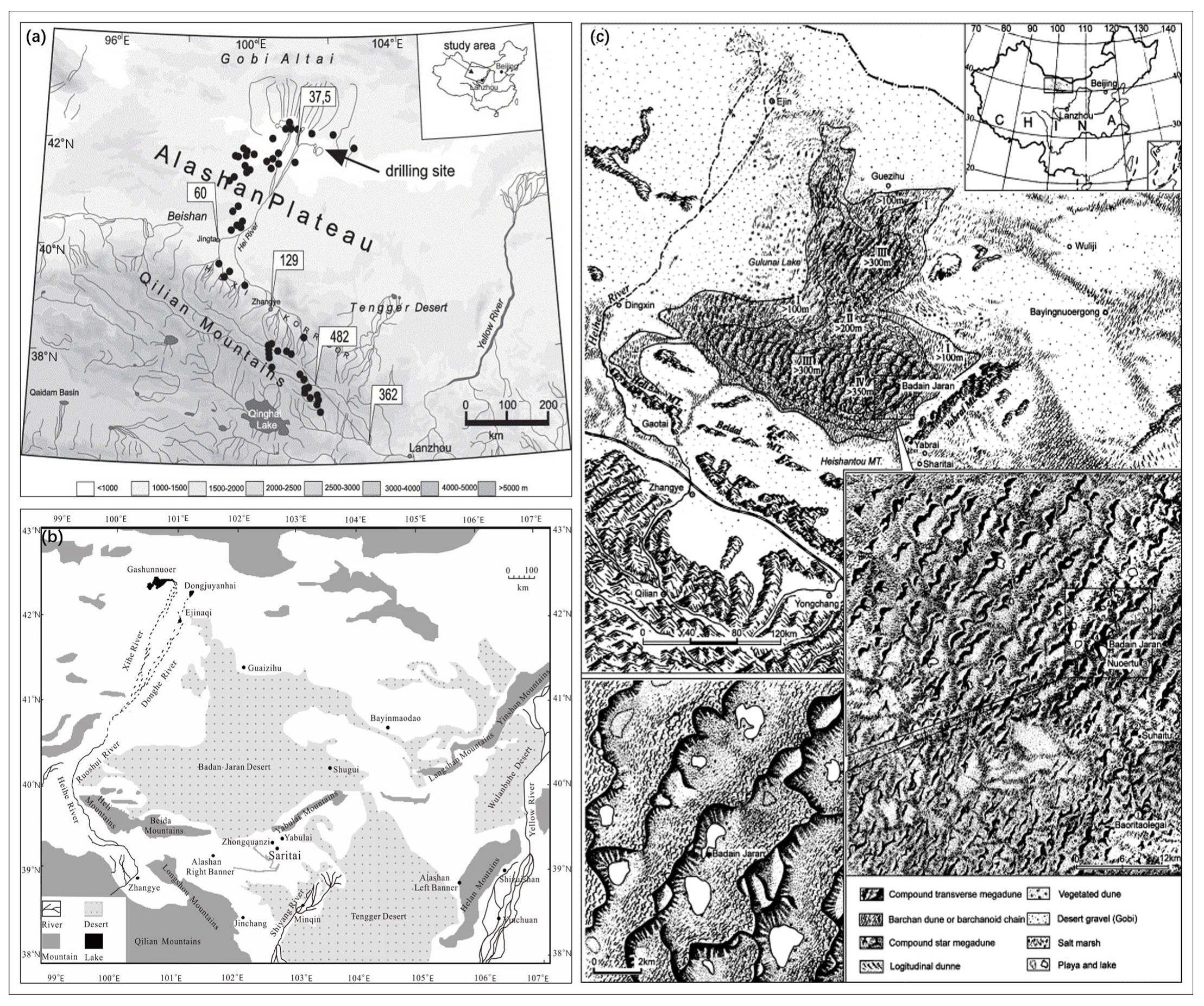
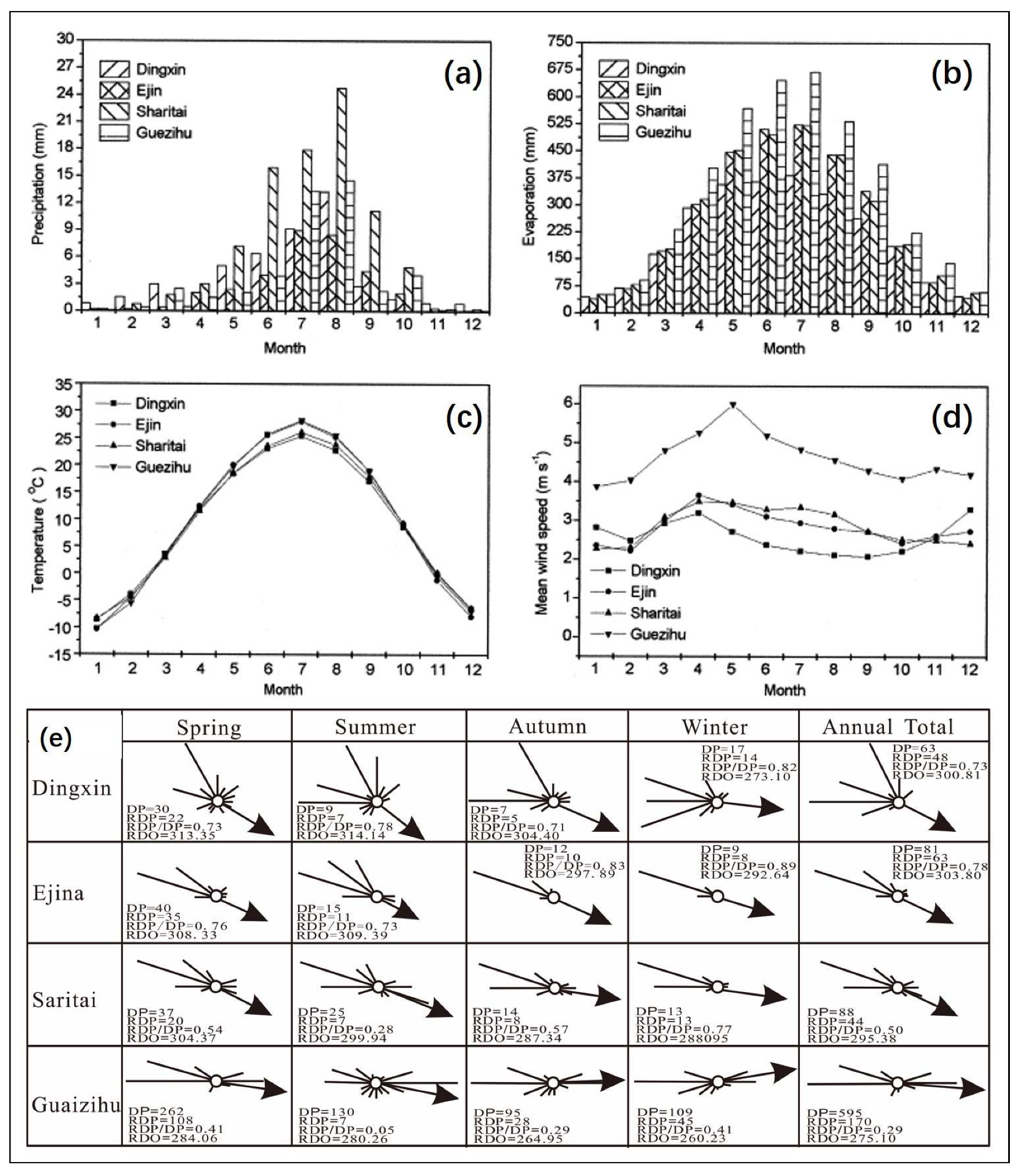

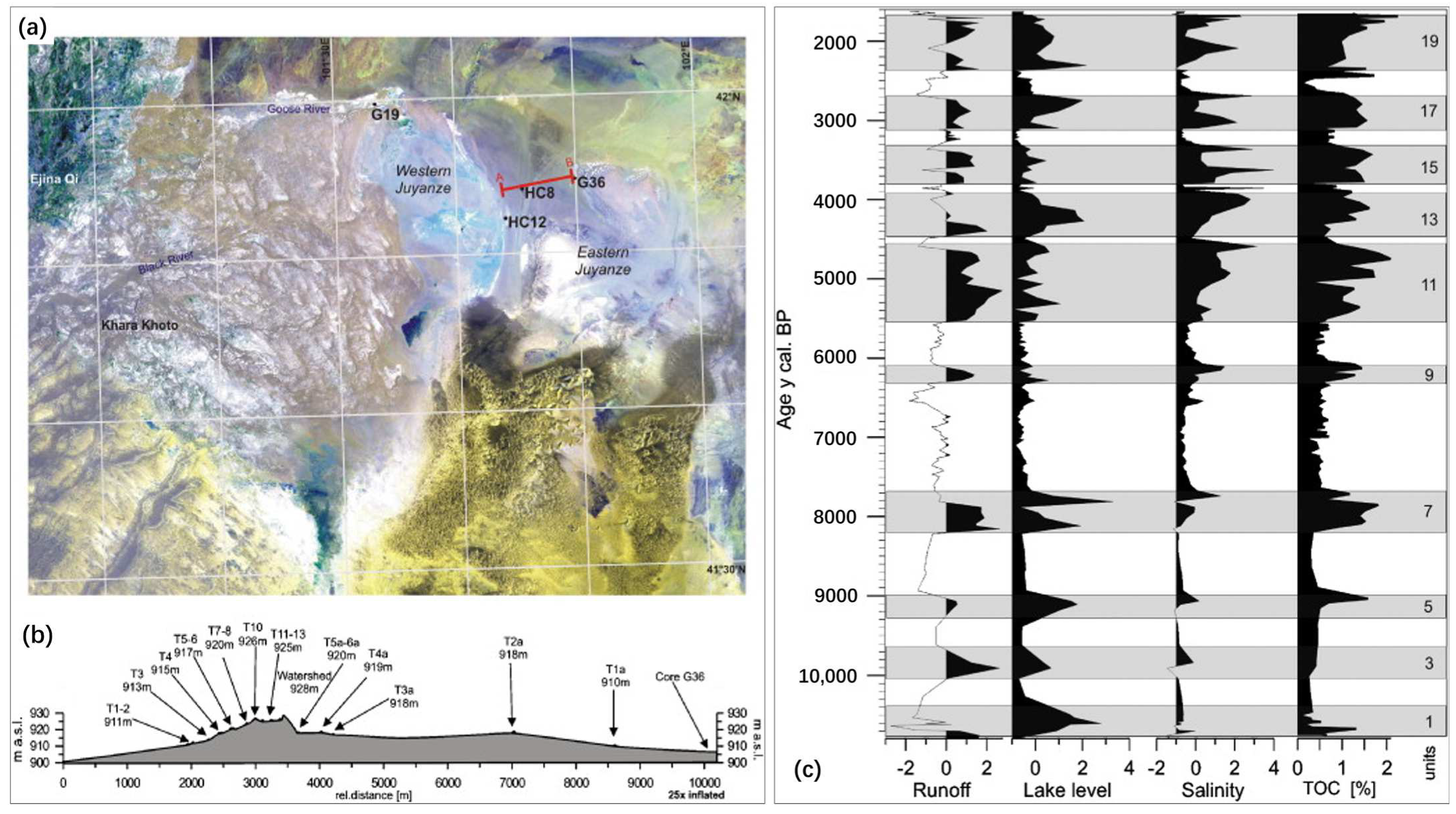
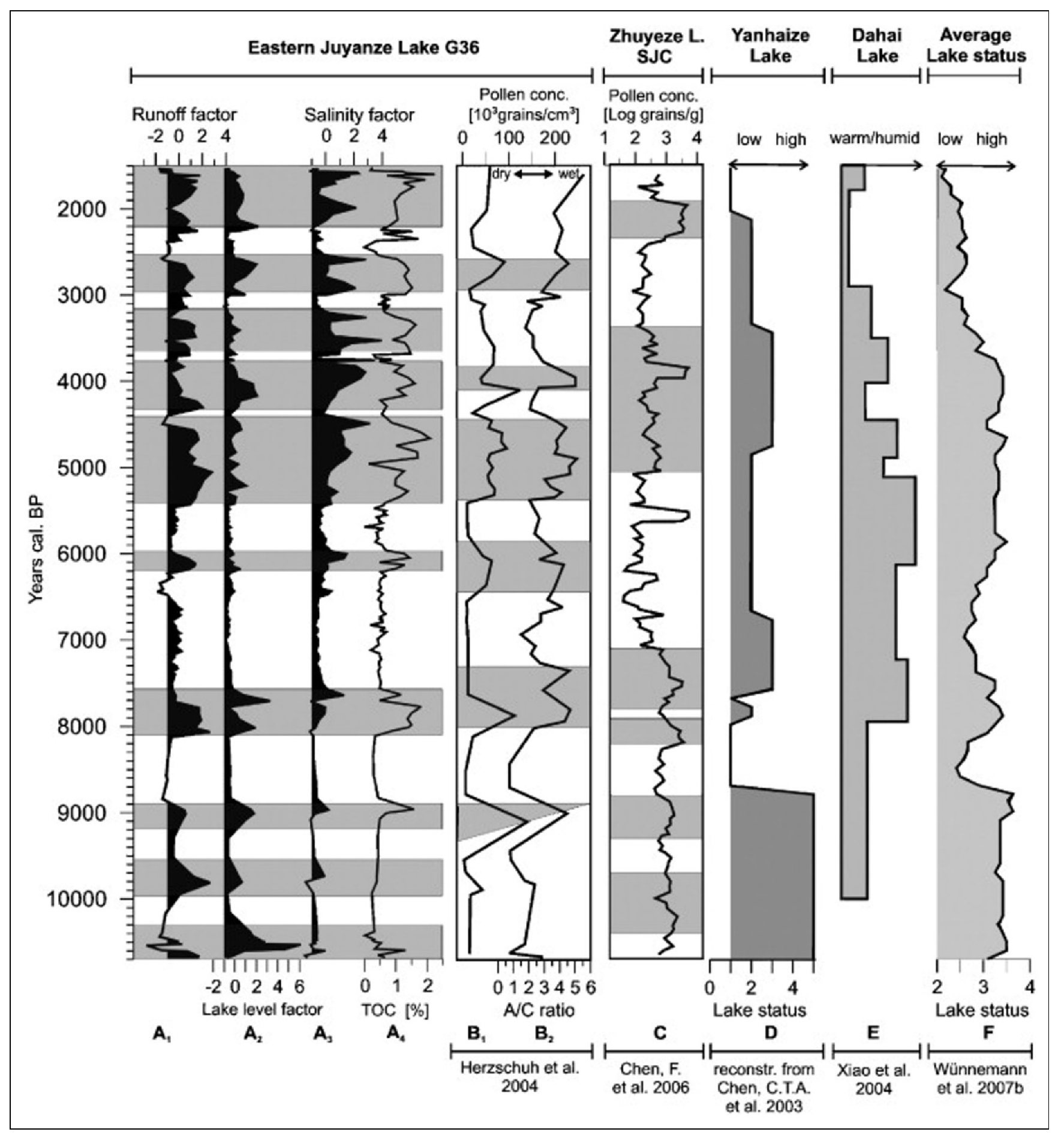
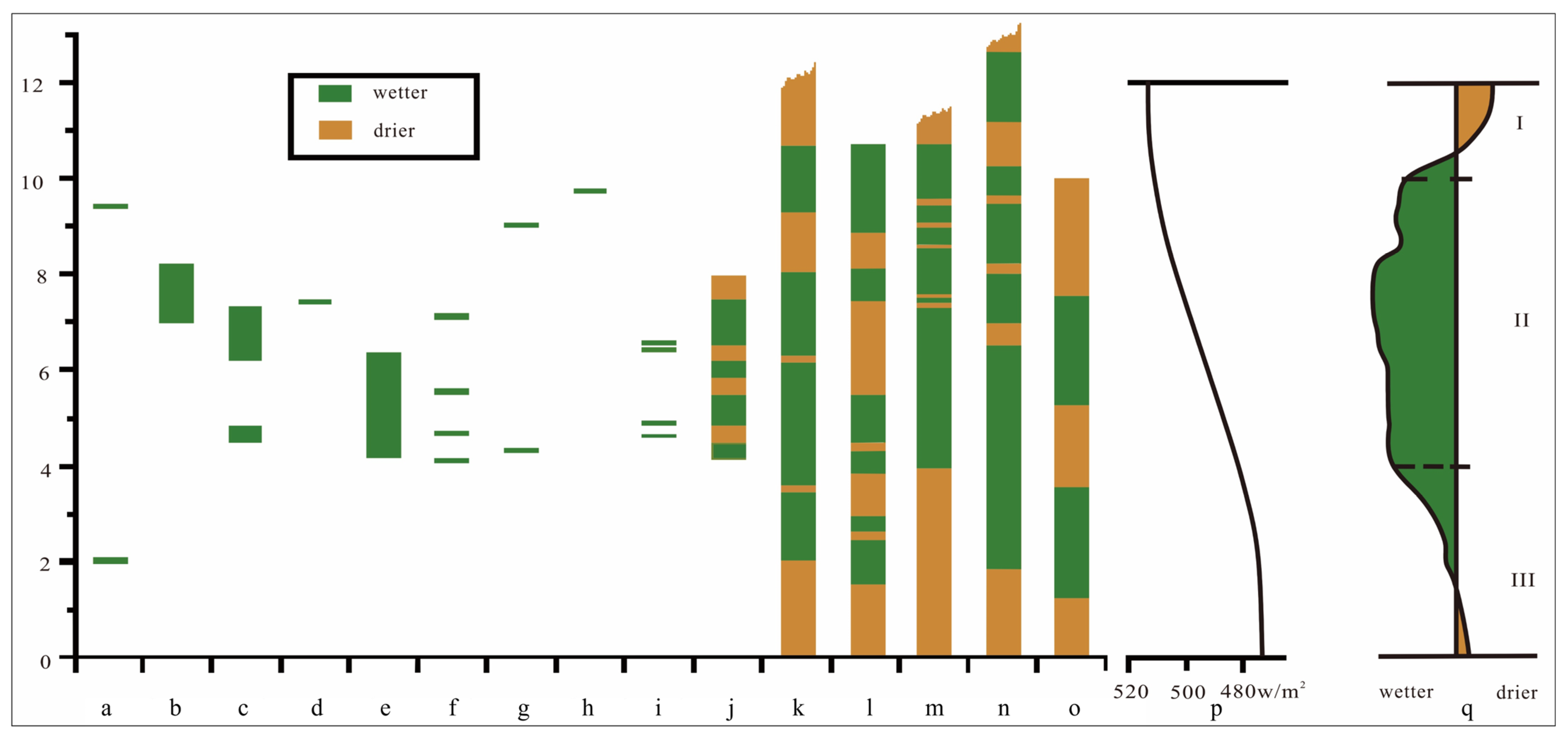
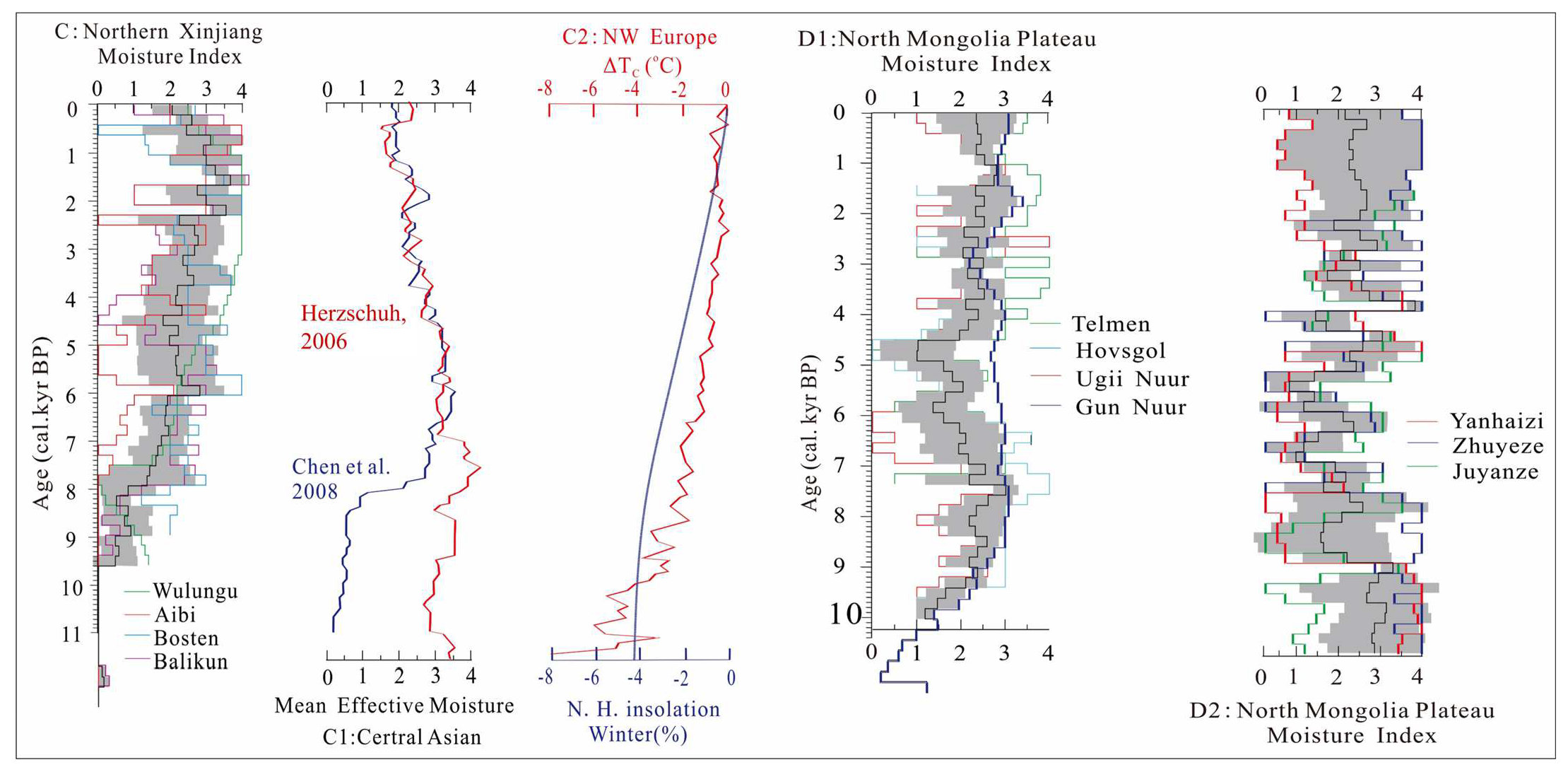
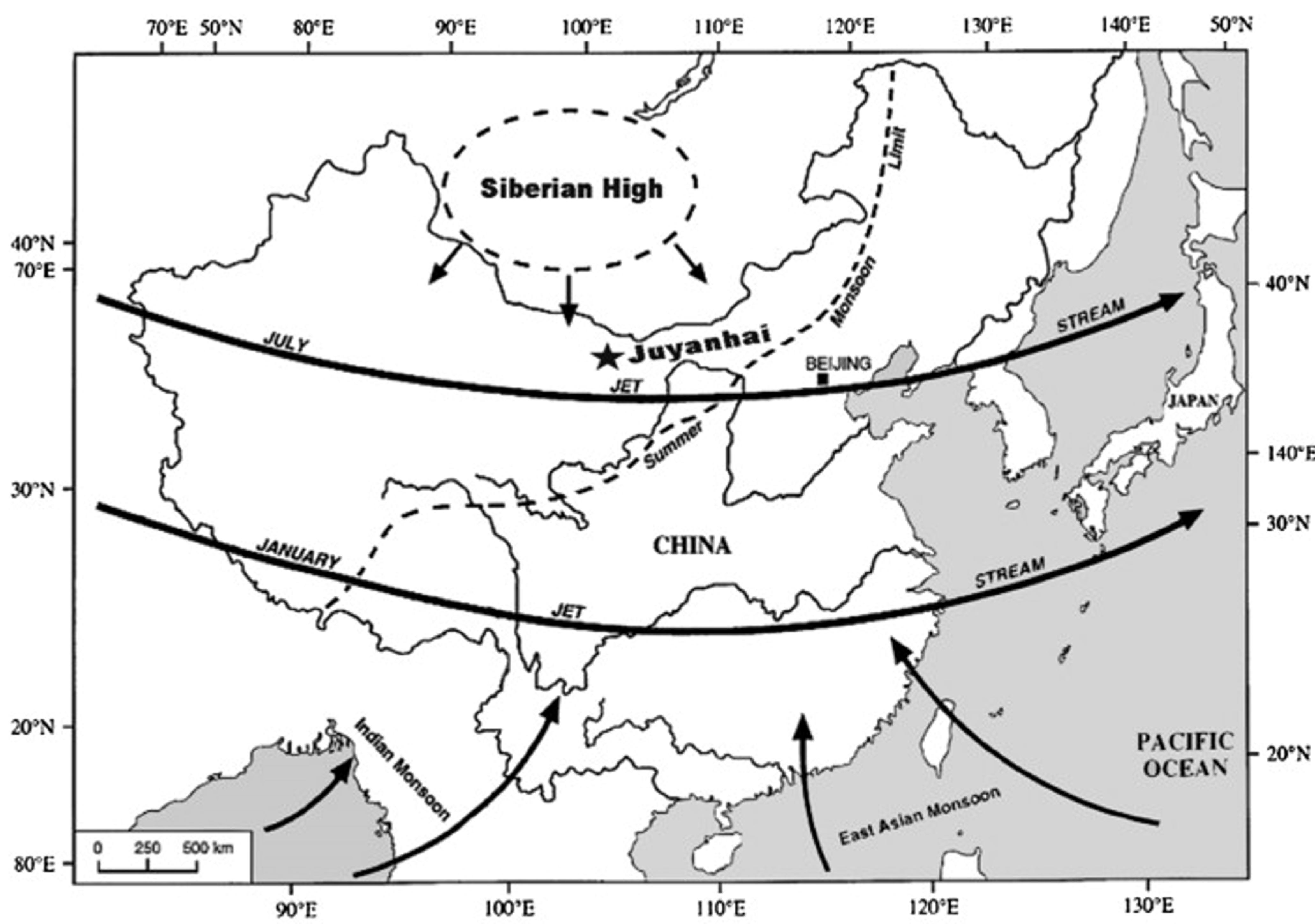
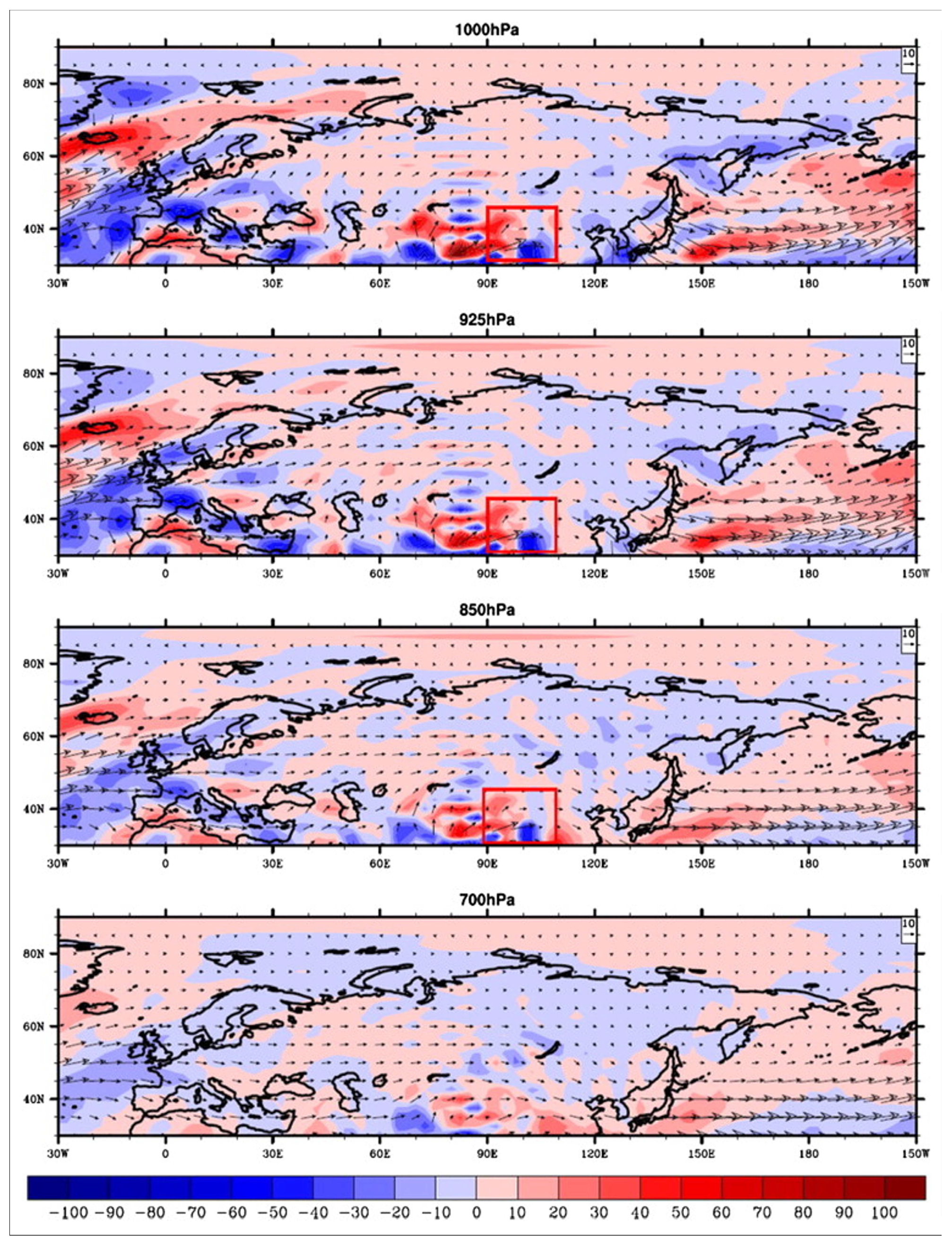
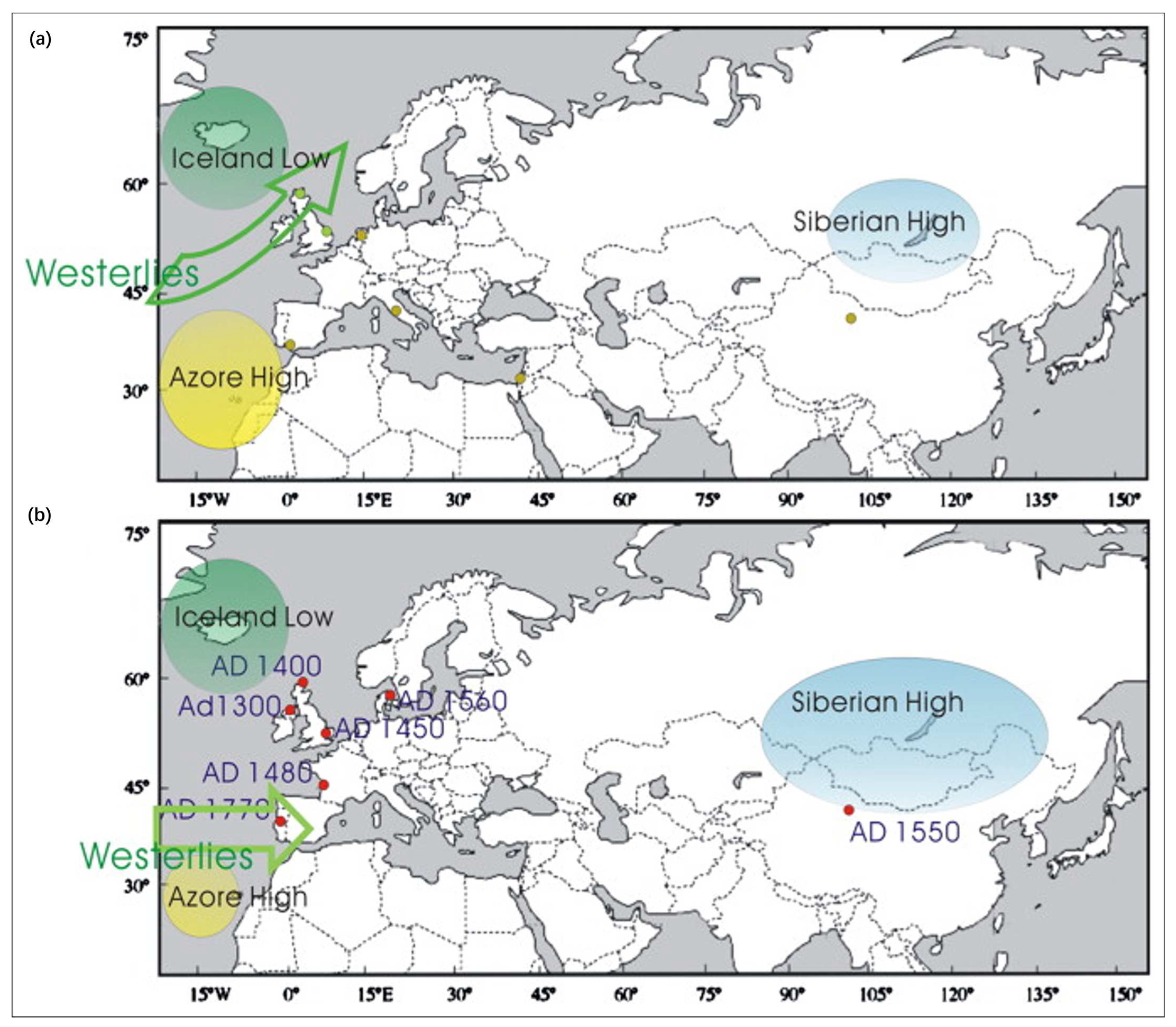
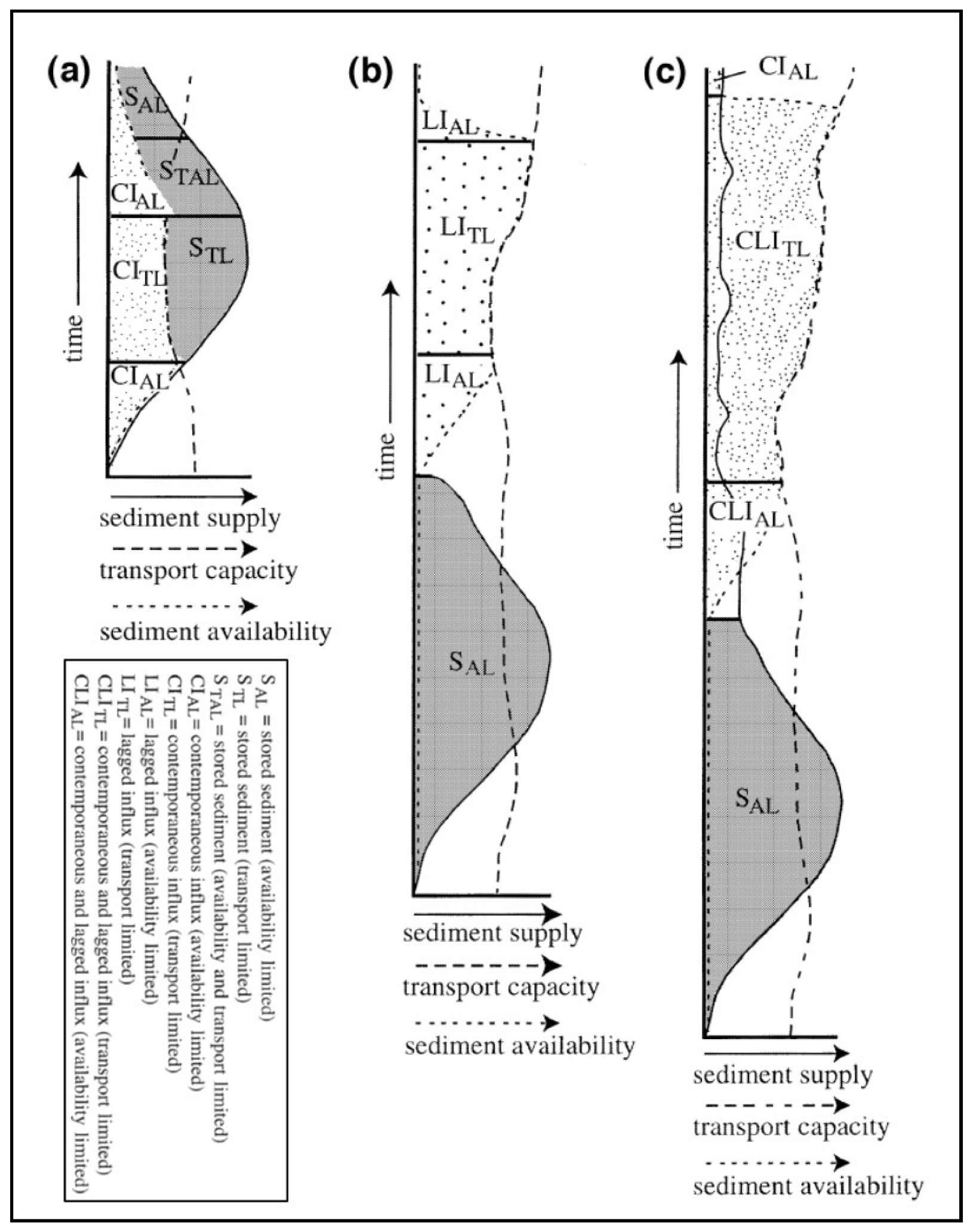
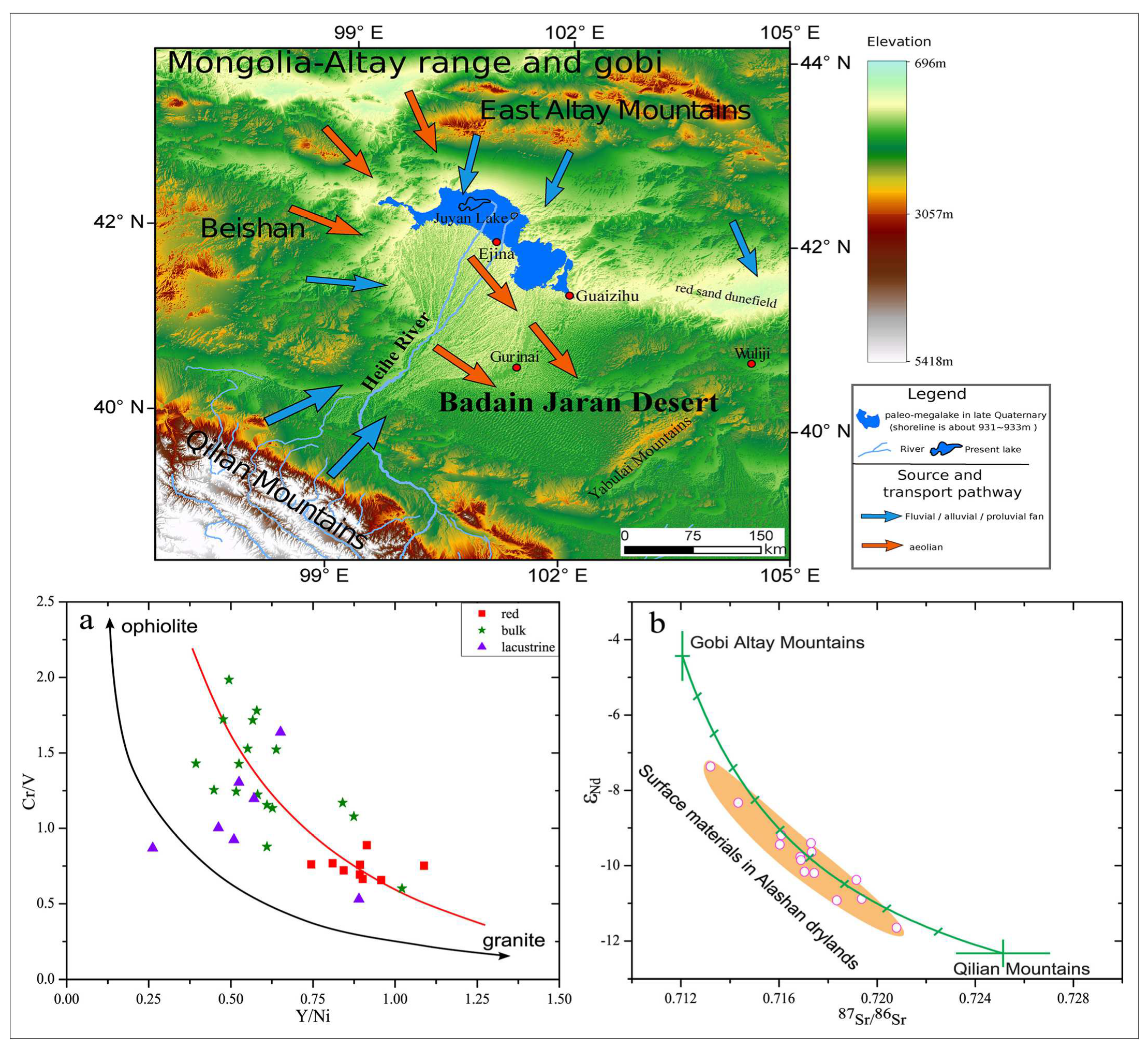

| Region | Location | Research Object | Dating Method | Dating Results | References |
|---|---|---|---|---|---|
| Badanjilin Desert | Piedmontplain | Landforms and landscape | Climatic geomorphology | Last glacial period | [37] |
| Sand mountains | Calcareous cements | 14C dating | ca. 30, 20, 19 ka BP | [39] | |
| Southeastern edge | Loess deposits | TL dating | ca.30~20 ka | [41] | |
| Juyan Lake | Lake cores | Palaeomagnetism, radioisotope analysis, TL/IRSL dating | 37~34, 31, 28~26 ka BP | [38] | |
| Gashunnuoer Lake | Calcium carbonate deposits | 14C dating | ca. 34, 21 ka BP | [40] | |
| Tenggeli Desert | Duantouliang, Baijing Lake | Calcium carbonates, shells | 14C dating | 39~23 ka BP | [40] |
| Palaeolakes | Organic matter, shells, calcium carbonates | 14C dating | 35~22 ka BP | [34] |
| Region | Location | Research Object | Dating Method | Dating Results | References |
|---|---|---|---|---|---|
| Sand mountains | Calcareous cement layers | 14C | ca. 9, 2 ka BP | [39] | |
| Badanjilin Desert | Lakes | Organic matter | 14C | 9~4 ka BP | [10] |
| Yindeertu Lake, Badan Lake | Organic matter, sands | 14C, TL | 7 ka 14C BP, ca.1 ka | [41] | |
| Huhejilin Lake | Organic matter, sands | 14C, TL | 8~7 cal ka BP | [16] | |
| Lakes | Organic carbon, inorganic carbon, shells, travertine | 14C, Uranium series dating | ca. 10 ka, 9~4 cal ka BP | [16] | |
| Juyanze Lake | Calcium carbonates | AMS | 10.7~8.9, 5.4~5 cal ka BP | [46] | |
| Tenggeli Desert | Qingtuhu Lake | Organic matter, calcium carbonates | AMS | 7.2~3.5 cal ka BP | [35] |
| Hongshuihu Lake | Sporomorphs | AMS | 7.4~5.7, 4.5~3.5 cal ka BP | [35] | |
| Zhuyeze Lake | Sand sediments | OSL | 8~5 ka | [51] | |
| Wulanbuhe Desert | Palaeolakes | Sand sediments | OSL | 8.3~6.5 ka | [36] |
| North part of the desert | Sand sediments | OSL | 8.6~6.4 ka | [15] |
Disclaimer/Publisher’s Note: The statements, opinions and data contained in all publications are solely those of the individual author(s) and contributor(s) and not of MDPI and/or the editor(s). MDPI and/or the editor(s) disclaim responsibility for any injury to people or property resulting from any ideas, methods, instructions or products referred to in the content. |
© 2023 by the authors. Licensee MDPI, Basel, Switzerland. This article is an open access article distributed under the terms and conditions of the Creative Commons Attribution (CC BY) license (https://creativecommons.org/licenses/by/4.0/).
Share and Cite
Zhu, B.; Yang, L. Desertification and Related Climate Change in the Alashan Plateau since the Last 40 ka of the Last Glacial Period. Atmosphere 2023, 14, 384. https://doi.org/10.3390/atmos14020384
Zhu B, Yang L. Desertification and Related Climate Change in the Alashan Plateau since the Last 40 ka of the Last Glacial Period. Atmosphere. 2023; 14(2):384. https://doi.org/10.3390/atmos14020384
Chicago/Turabian StyleZhu, Bingqi, and Limin Yang. 2023. "Desertification and Related Climate Change in the Alashan Plateau since the Last 40 ka of the Last Glacial Period" Atmosphere 14, no. 2: 384. https://doi.org/10.3390/atmos14020384
APA StyleZhu, B., & Yang, L. (2023). Desertification and Related Climate Change in the Alashan Plateau since the Last 40 ka of the Last Glacial Period. Atmosphere, 14(2), 384. https://doi.org/10.3390/atmos14020384





